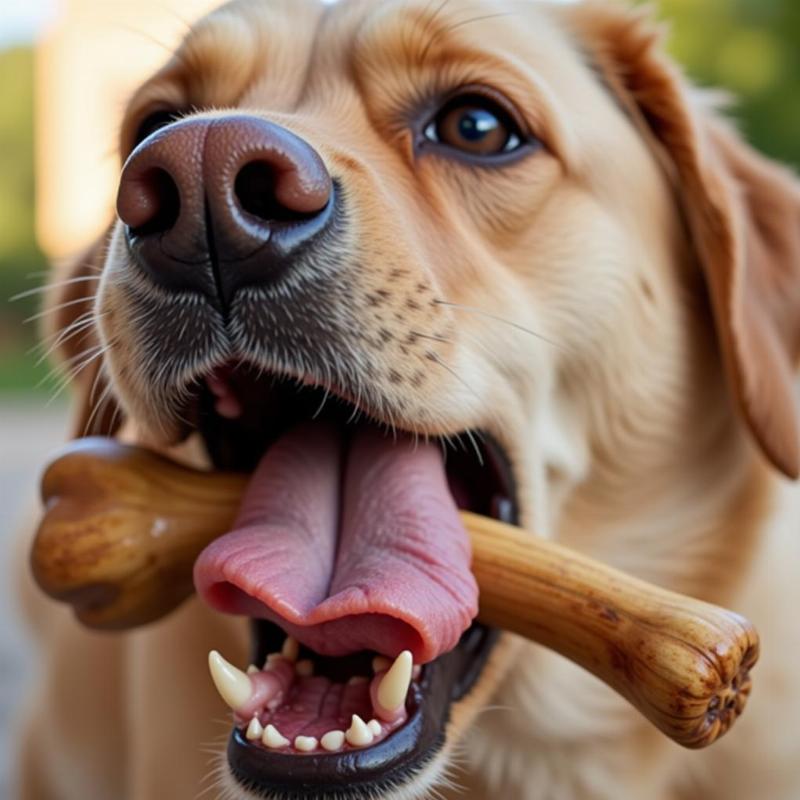Ham bones seem like a tasty treat for your furry friend, especially after a holiday feast. However, feeding your dog a ham bone can be incredibly dangerous and could lead to serious health issues. So, while it might be tempting to share, it’s crucial to understand why ham bones are a no-go for your canine companion.
The Dangers of Ham Bones for Dogs
While cooked bones in general pose a risk, ham bones are particularly hazardous. The cooking process makes them brittle and prone to splintering. These sharp bone fragments can cause a multitude of problems, from choking and mouth injuries to more severe internal damage.
- Choking: A large piece of ham bone can easily become lodged in your dog’s throat, blocking their airway and causing them to choke. This is a life-threatening emergency.
- Mouth and Esophageal Injuries: Splintered bone fragments can pierce your dog’s gums, tongue, or esophagus, leading to painful infections.
- Intestinal Blockages: Swallowed bone fragments can get stuck in your dog’s intestines, creating a blockage that prevents food from passing through. This can lead to vomiting, constipation, and abdominal pain, requiring emergency surgery.
- Peritonitis: In severe cases, sharp bone fragments can perforate the stomach or intestines, releasing bacteria into the abdominal cavity and causing a life-threatening infection called peritonitis.
- Pancreatitis: Ham is high in fat, and the richness can trigger pancreatitis in dogs, a painful inflammation of the pancreas.
 Dog with bone stuck in its throat
Dog with bone stuck in its throat
Safe Alternatives to Ham Bones
Instead of risking your dog’s health with a ham bone, opt for safe and healthy alternatives designed specifically for dogs.
- Dental Chews: These are specifically designed to help clean your dog’s teeth and satisfy their chewing instincts.
- Durable Rubber Toys: Kongs and other sturdy rubber toys are a great option for dogs who love to chew.
- Rawhide Chews (with supervision): While rawhide can be controversial, if chosen carefully (look for high-quality, US-sourced products) and given under supervision, they can satisfy a dog’s chewing urge.
- Commercial Dog Treats: There are countless dog treats available in pet stores, formulated to be safe and enjoyable for dogs.
What to Do if Your Dog Eats a Ham Bone
If your dog manages to snag a piece of ham bone, monitor them closely for any signs of distress. Look for:
- Vomiting
- Constipation
- Loss of appetite
- Whining or yelping in pain
- Difficulty breathing or swallowing
- Bloody stool
If you notice any of these symptoms, contact your veterinarian immediately. Time is of the essence in these situations, and prompt veterinary care can be the difference between life and death.
What about Other Cooked Bones?
Just like ham bones, other cooked bones, such as chicken, turkey, and pork bones, are dangerous for dogs. They all share the same risks of splintering and causing internal damage. It’s best to avoid giving your dog any cooked bones. If you’re looking for ways to incorporate raw meat into your dog’s diet, consider cheap cuts of meat for dogs and ensure they are appropriately prepared.
Can Dogs Have Raw Ham?
While raw ham is less likely to splinter than cooked ham bones, it still poses risks such as bacterial contamination and the potential to upset your dog’s stomach. Also, the high fat content of ham can contribute to pancreatitis. If you’re considering a raw food diet for your dog, learn more about the safety and benefits, particularly regarding raw poultry, such as can dogs have raw chicken wings. A balanced diet like hamburger and rice for dogs is often a safer and healthier choice.
Conclusion
While it might be tempting to share your ham bone with your furry friend, the risks significantly outweigh any potential benefits. Prioritize your dog’s health and safety by steering clear of ham bones and opting for safe, dog-friendly alternatives. Remember, a happy and healthy dog is a dog who isn’t chewing on dangerous bones.
FAQ
- Can a small piece of ham bone hurt my dog? Yes, even small splinters can cause serious internal damage.
- What should I do if my dog swallowed a ham bone and is showing no symptoms? Contact your veterinarian immediately, even if your dog seems fine.
- Are smoked ham bones safer than baked ham bones? No, all cooked ham bones are dangerous for dogs.
- What are some signs of intestinal blockage in dogs? Vomiting, constipation, lethargy, and loss of appetite.
- Can I give my dog a ham bone if I supervise them? No, supervision doesn’t eliminate the risk of splintering.
- Are there any types of bones that are safe for dogs? Some raw bones, specifically those recommended by veterinarians, can be suitable. However, it’s crucial to consult with your vet first.
- What if my dog has fleas? What do I do? If your dog has fleas, it’s best to address that separately. Look into options such as does lice shampoo kill fleas on dogs for appropriate treatment.
Beautdogs.us is your premier online resource for comprehensive and reliable information on dog breeds, care, and products, catering to both new and experienced dog owners in the USA. We combine veterinary expertise with engaging content to ensure your furry friend receives the best possible care. Explore our website for expert advice, product reviews, and valuable resources to enhance your dog’s life. Contact us today for personalized support! Email: [email protected], Phone: +1 501-555-7529. Visit Beautdogs.us for all your dog-related needs!